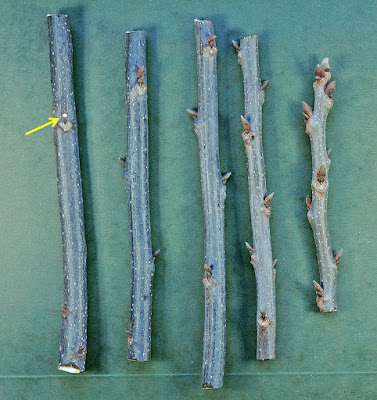If you are a long time reader of this blog, you may recall that we have been thinning a block of Kanza trees a little bit each year for the past several years. Today, I took advantage of the warm sunshine to walk through our Kanza block and mark trees for removal this winter.
In some areas of this 3 acre block of trees the canopies of adjacent trees are beginning to almost touch (photo above, right). In these areas, I flagged some trees for removal.
But just a couple of tree rows away, trees have not grown as fast and adjacent trees still have plenty of room to grow (photo at left). You might be wondering why, in such a relatively small area (3 acres), are our Kanza trees growing at such different rates. The answers is simple--small changes in soil conditions. All the trees in this block are growing in a soil classified as Osage Silty Clay. However, all soil types contain minor variations that can effect tree growth. The fastest growing trees in this block are growing in areas that are slightly more silty. In contrast, the slowest growing trees are found in soil with more clay.
The initial tree spacing for this orchard was 30 feet by 30 feet. We started thinning this grove in 2012. After thinning, the trees are left at a 42 foot by 42 foot spacing (photo at right). As you can see, the canopies of adjacent trees have ample room intercept sunlight and grow new nut bearing wood.
After walking the grove today, I marked 9 trees for removal this winter. The blog posts listed below will give you the history of our thinning program in this block of Kanza trees.
2012 Making the decision to thin Trees
2012 Thinning a Kanza Block
2014 Early spring thinning
2015 Time to think about tree thinning
2015 Sticking to the plan
In some areas of this 3 acre block of trees the canopies of adjacent trees are beginning to almost touch (photo above, right). In these areas, I flagged some trees for removal.
But just a couple of tree rows away, trees have not grown as fast and adjacent trees still have plenty of room to grow (photo at left). You might be wondering why, in such a relatively small area (3 acres), are our Kanza trees growing at such different rates. The answers is simple--small changes in soil conditions. All the trees in this block are growing in a soil classified as Osage Silty Clay. However, all soil types contain minor variations that can effect tree growth. The fastest growing trees in this block are growing in areas that are slightly more silty. In contrast, the slowest growing trees are found in soil with more clay.
The initial tree spacing for this orchard was 30 feet by 30 feet. We started thinning this grove in 2012. After thinning, the trees are left at a 42 foot by 42 foot spacing (photo at right). As you can see, the canopies of adjacent trees have ample room intercept sunlight and grow new nut bearing wood.
After walking the grove today, I marked 9 trees for removal this winter. The blog posts listed below will give you the history of our thinning program in this block of Kanza trees.
2012 Making the decision to thin Trees
2012 Thinning a Kanza Block
2014 Early spring thinning
2015 Time to think about tree thinning
2015 Sticking to the plan

















